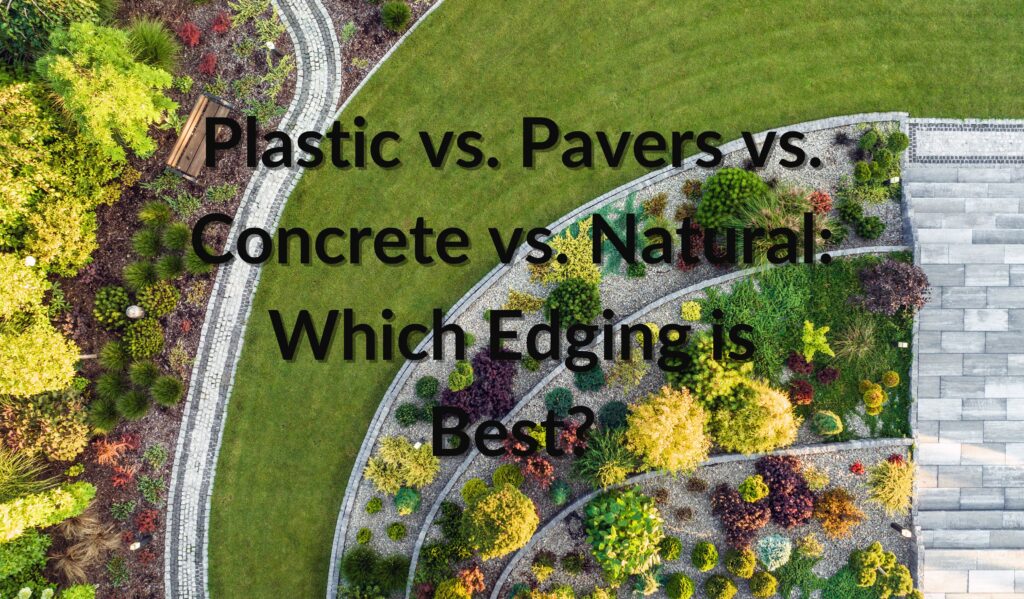Table of Contents
When planning a landscape project, one crucial element that often requires careful consideration is the type of edging used to define your spaces. Edging plays a vital role in enhancing the appearance of your garden or yard, keeping grass from creeping into flower beds, and providing structure to different areas. The choice of edging material can significantly impact the aesthetic, functionality, and durability of your landscape design. With various options available—such as plastic, pavers, concrete, and natural materials—it can be difficult to decide which is best for your particular needs. This guide breaks down the pros and cons of each type of edging to help you make an informed decision.
1) Plastic Edging
Plastic edging is one of the most commonly used materials for garden and lawn borders, known for its affordability and ease of installation. It is typically made from polyethylene, a flexible material that allows it to conform to various shapes, making it suitable for curved garden beds and borders.
Pros:
- Affordability: Plastic edging is one of the least expensive materials available, making it a popular choice for those on a tight budget or working on small-scale projects.
- Easy to Install: For DIY landscapers, plastic edging is simple to install. It can be placed directly into the soil with little preparation, and most products are designed to easily bend, allowing you to create custom curves and shapes.
- Versatility: Plastic edging comes in different colors and designs, so you can match it to your existing landscape elements or opt for a material that mimics other, more expensive types of edging.
Cons:
- Durability: Plastic edging is not as durable as other options. It can become brittle in cold climates and may crack, warp, or fade when exposed to UV rays over time.
- Limited Aesthetic Appeal: While plastic is practical, it often lacks the refined look of more durable materials like pavers or concrete. Over time, plastic can deteriorate, causing the garden to look worn out.
- Shorter Lifespan: Because plastic is not as long-lasting, you may find yourself needing to replace or repair the edging more frequently compared to other materials.
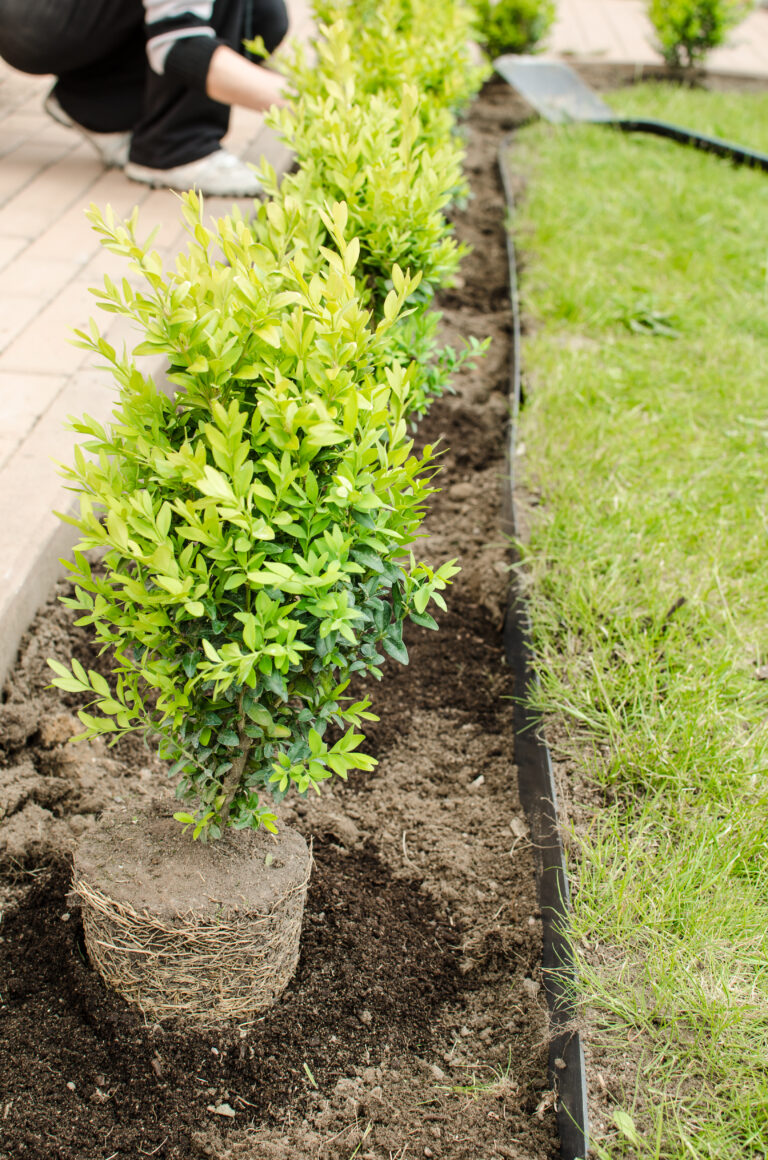
2) Paver Edging
Paver edging is a popular choice for those looking for a durable, decorative solution. Pavers are made from materials such as concrete, brick, or stone and are commonly used in formal or structured gardens. The material offers a balance between durability and aesthetic appeal, making it one of the more versatile options for garden borders.
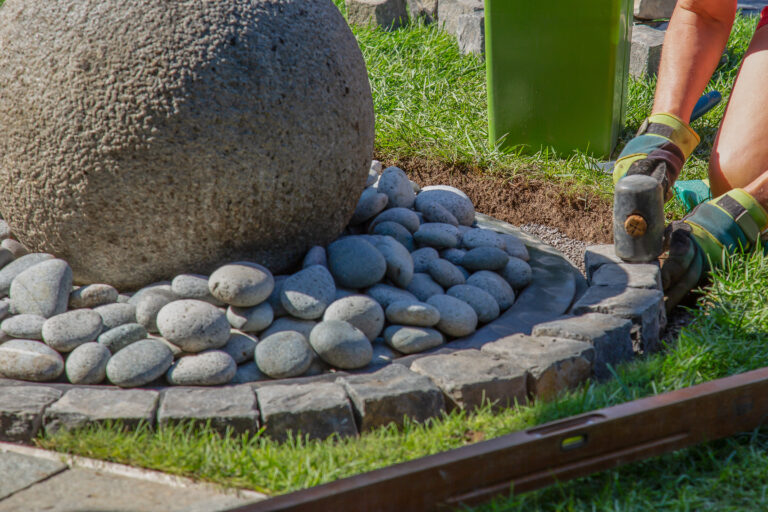
Pros:
- Aesthetic Appeal: Pavers are highly customizable and available in many styles, colors, and shapes. They can complement various types of landscapes, from formal to natural. Pavers offer a polished, upscale appearance that enhances the overall look of your garden.
- Durability: Pavers are built to last. They are weather-resistant, can handle heavy foot traffic, and are less likely to shift or crack compared to plastic. Properly installed paver edging can last decades with minimal maintenance.
- Design Flexibility: Because pavers are available in various shapes, they offer great flexibility in design. You can create straight lines, curves, or intricate patterns, making them ideal for a custom landscaping project.
Cons:
- High Cost: Paver edging is more expensive than plastic or natural options. The cost of materials can add up, especially for large areas, and installation may require professional help, further increasing the cost.
- Labor-Intensive Installation: Paver edging requires careful installation. You’ll need to dig trenches, ensure a level base, and potentially add sand or gravel for stability. This often necessitates hiring a professional for larger or more complex designs.
- Maintenance: While durable, pavers can still settle or shift over time. You may need to periodically re-level them or repair cracks that develop from weather exposure or heavy use.
3) Concrete Edging
Concrete edging is one of the most durable and long-lasting options available. It can be poured in place or pre-formed into various shapes, providing a sleek, modern finish to your garden or yard. While more costly and labor-intensive than plastic or natural materials, concrete offers superior strength and longevity.
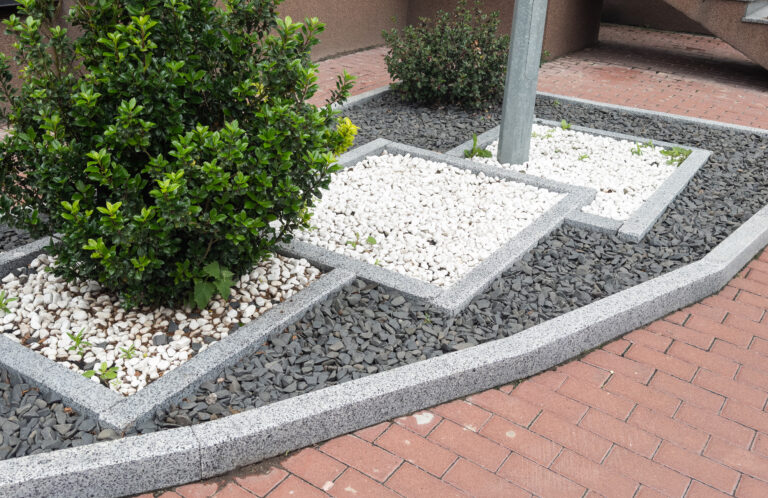
Pros:
- Exceptional Durability: Concrete is one of the most long-lasting materials available for edging. It can withstand weather extremes, heavy foot traffic, and lawn equipment without breaking down. Properly installed concrete edging can last for decades with minimal upkeep.
- Customizability: One of the main advantages of concrete is its versatility. It can be poured into any shape or size, allowing for unique designs that fit the landscape’s contours perfectly. You can also choose from different finishes—smooth, stamped, or colored—to match your garden’s aesthetic.
- Minimal Maintenance: Once installed, concrete requires little to no maintenance. Unlike plastic or natural edging, which can shift or deteriorate over time, concrete provides a permanent solution.
Cons:
- High Cost: Concrete edging is one of the most expensive options due to the material cost and the labor involved. Installation typically requires professional expertise, adding to the total expense.
- Rigid Design: Concrete, while customizable, is not as flexible as other materials in terms of installation. It can be difficult to achieve intricate curves or irregular shapes without advanced techniques. Once installed, it is permanent and difficult to change.
- Potential for Cracking: Over time, concrete can develop cracks due to soil movement, temperature changes, or heavy use. However, these issues are less frequent compared to other materials like plastic.
4) Natural Edging
Natural edging involves using organic materials such as rocks, logs, or a simple trench to define garden beds and paths. It provides a more rustic, eco-friendly alternative to manufactured materials like plastic or concrete. Natural edging is particularly suited to informal gardens, wildlife gardens, or properties with a strong focus on sustainability.
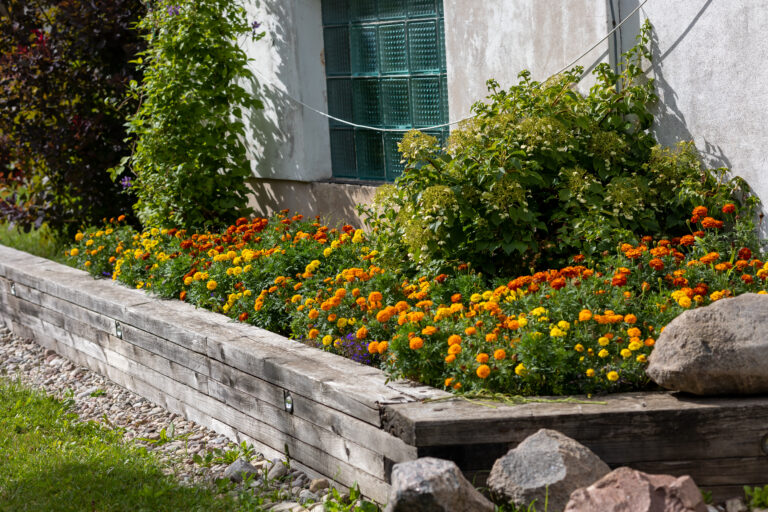
Pros:
- Environmentally Friendly: Natural edging often uses materials already present in the environment, such as stones or wood, making it an eco-friendly choice. It reduces waste and doesn’t require the manufacturing process involved in other materials like plastic or concrete.
- Blends with the Landscape: Natural edging creates a soft, organic border that blends seamlessly into the surrounding environment. It works particularly well in informal or cottage-style gardens where a formal, polished appearance is not necessary.
- Low Cost: Depending on the materials used, natural edging can be very affordable. If you collect stones or wood from your property, the cost can be almost nothing.
Cons:
- Less Defined Borders: While natural edging provides a beautiful, organic look, it’s not as effective at creating sharp, defined borders. This can make it harder to control the spread of grass or weeds, requiring more maintenance.
- High Maintenance: Natural materials like wood can decompose, and rocks may shift over time, requiring frequent adjustments. In areas with heavy rain or foot traffic, natural edging may need to be rebuilt or reinforced.
- Limited Durability: Natural materials generally don’t last as long as manufactured options like concrete or pavers. For example, logs may rot or attract pests, and rocks can erode or shift over time.
How to Choose the Best Edging for Your Landscape
When deciding which edging material is best for your landscape, consider the following factors:
Budget:
- Plastic edging is the most affordable option, ideal for budget-conscious homeowners.
- Natural edging can also be cost-effective, especially if using materials sourced from your own property.
- Pavers and concrete are more expensive but offer a longer lifespan and more aesthetic appeal.
Durability:
- Concrete edging is the most durable, lasting decades with minimal maintenance.
- Paver edging also offers excellent durability, particularly for high-traffic areas.
- Plastic edging is less durable and may need replacing after a few years, especially in extreme climates.
- Natural edging can wear down faster, as wood may rot, and rocks or logs can shift over time.
Aesthetic Appeal:
- Pavers provide the most versatility in terms of design, color, and texture, making them ideal for both traditional and modern landscapes.
- Concrete gives a sleek, polished look, perfect for formal and minimalist designs.
- Plastic is available in various styles but doesn’t have the high-end look of other materials.
- Natural edging offers a rustic, eco-friendly aesthetic, ideal for informal or cottage-style gardens.
Maintenance:
- Concrete requires the least maintenance, once installed.
- Pavers may need occasional adjustments but are generally low-maintenance.
- Plastic may require replacement or repairs as it ages and becomes brittle.
- Natural edging requires frequent upkeep to retain its form and prevent shifting or erosion.
Design Flexibility:
- Plastic edging is the most flexible, allowing for curved and intricate designs.
- Pavers offer customization but require more planning and effort to install.
- Concrete is customizable, but its rigidity limits design flexibility once installed.
- Natural edging is flexible in terms of design but harder to control in terms of creating sharp, defined borders.
Conclusion
Ultimately, the best edging material for your landscape depends on various factors, including your budget, aesthetic preferences, and maintenance expectations. Plastic edging is a cost-effective, flexible option for simple DIY projects, though it lacks durability and may not offer a high-end look. Pavers provide a polished, long-lasting solution, but they come at a higher cost and require more complex installation. Concrete edging is durable and low-maintenance, ideal for a clean, modern appearance, but it’s one of the most expensive and least flexible choices. Natural edging offers an eco-friendly and rustic approach, though it requires more frequent upkeep and may not be as effective at controlling borders.
Each material has its strengths and weaknesses, so consider your project’s specific requirements, including design complexity, budget, and longevity, when making your final choice. With the right edging, you can create a beautiful, well-defined landscape that enhances the overall look of your garden or yard for years to come. For more detailed information and tailored advice, visit our page on edging. For support on your next edging installation services project, please feel free to reach out through our contact form, and our team will be happy to help.



